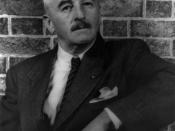The Character Puzzle
Human growth is an extraordinary anomaly. Every individual has their own way. Yet, the journey to maturity is hardly ever taken on a road with no bumps or sudden twists. Each personality must suffer conflict. Then, they must learn and grow from this in order to go through the 'rites of passage'. The age people achieve this varies, and some never see the other side. For the ones that do cross the bridge, maturity doesn't happen all at once. True adulthood is a puzzle, and each piece is a conflict that helps to form the character. This vital piece of information is valid for character building in literature as well. The main protagonists in most fictional short stories are round characters, individuals undergoing complex emotions who are libel to change somehow during the plot. Although readers don't normally view the puzzle in its entirety within a short story, they observe the placement of at least one missing piece.
The authors of the week, Barry Hannah, Raymond Carver, and William Faulkner exemplify the character puzzle process, known as characterization, in literature.
To begin with, through first person characterization, Hannah reveals his protagonist, the narrator, as a thirty-three year old, somewhat religious, man shrouded with flaws consisting of jealousy and pride in "Water Liars". As the story progresses, the narrator works through a couple of these faults. Thus, he finds where one of his puzzle pieces belongs and earns his right to be called a round character. The narrator begins his tale by explaining he is in the midst of a conflict. "When I am run down and flocked around by the world, I go down to Farte Cove off the Yazoo River and take my beer to the end of the pier where the old liars are...


